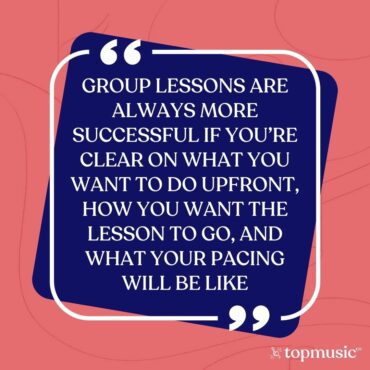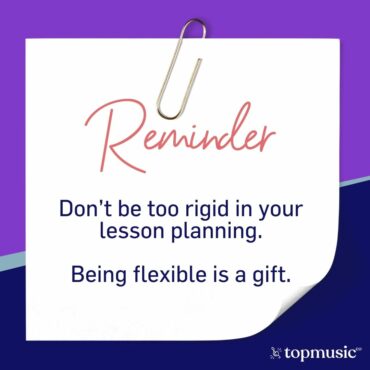Being a private music teacher can be overwhelming and stressful. Planning can help you feel calm and present and avoid that stressed feeling of starting a stretch of 8 lessons without a complete roadmap.
We’re here with some advice from teacher Janna Williamson. Read on for music lesson planning tips to help prepare your students for the best possible experience and outcomes.
Being a private music teacher can be overwhelming and stressful. Planning can help you feel calm and present and avoid that stressed feeling of starting a stretch of 8 lessons without a complete roadmap.
We’re here with some advice from teacher Janna Williamson. Read on for music lesson planning tips to help prepare your students for the best possible experience and outcomes.
Table Of Contents:
Janna Williamson runs an independent piano studio in the suburbs of Chicago and coaches piano teachers worldwide.
She has been an MTNA Nationally Certified Teacher of Music since 2004 and holds bachelor’s and master’s degrees in piano performance.
Janna enjoys performing solo or collaboratively and can be heard throughout the Chicago area on a regular basis.
Her TopMusicPro series, Piece by Piece, equips teachers with how they can successfully present intermediate repertoire in their studios.
Here are Janna’s tips for planning your music lessons:
Before we dive into the tips, let’s think about a few benefits of lesson planning:
There is no “perfect” way to plan your lessons. Nor is there a way that will work for every single teacher.
Lesson plans will differ depending on:

When teaching private lessons, you have much more flexibility to tailor the lesson to the individual student.
You can observe what the student has done throughout the week to see if they were practicing or not practicing at home and be more responsive to that.
You can even have backup activities planned in case of unpredicted events (for example, if they turn up from school having burnt their finger in cookery class!)
I can tell you from first-hand experience that if you’re teaching group classes, you want to PLAN.
I taught group classes at Yamaha Music School for many years, and I would make very detailed plans for those groups. Planning is especially needed when you’re working with young children aged four to five.
With those ages, you don’t have any room not to know what you’re doing. I always joke that preschoolers can smell fear!
Group lessons are always more successful if you’re clear on what you want to do upfront, how you want the lesson to go, and what your pacing will be like.
Beginner students, especially young beginners, can typically require lots of activities planned.
To stop students from becoming fidgety and losing focus, you’ll want to plan many activities – both on and off the bench.
Having many activities at your fingertips can help your lessons with beginner students run smoothly.
Before a student’s lesson, have a flick through their method book and see what they’ll be working on. Plan an activity that relates to their last lesson to revise what they covered before, and then plan an activity that relates to the next page in the book to help reinforce what they’re learning.

At this stage in my teaching, I work with many intermediate-level students.
They require a different type of lesson planning. It’s less about just what’s happening in the individual lesson and more about how it fits into the bigger picture.
When your students reach the intermediate level, you no longer have method books or a pre-planned curriculum to follow. Instead, you have to plan your own curriculum, working with your students to figure out what their overall goal is.
This can be a daunting process, but we have something for you – a free eBook (written by Janna herself) titled “The Ultimate Guide to Intermediate Curriculum Planning.”
Your download link is at the end of this blog.
I personally spend a fair amount of extra time in repertoire planning – this is more challenging the more advanced your students get.
My top tip for planning repertoire for intermediate students is to put them in an intermediate repertoire collection.
This way, you don’t have to plan every single piece of music.
Instead, you can rely on the grading and level of a good anthology.
Once you’ve reached the tipping point of learning, and your student has accomplished as many pieces as you wanted, you can move on to the next level or choose a different collection.
When a student has worked their way through the method books, they’re ready to move on to repertoire pieces.
Reduce your stresses and moments of uncertainty by planning how you’ll introduce your students to new pieces.

After you’ve introduced the piece and looked through the score, it’s time to ask your student the magic question:
How will you practice this piece?
This is when you help your student make plans.
Guide them through the process of figuring out how they’re going to tackle the piece. For example:
Write down these steps on their assessment sheet (or get them to write them down) so they can remember what you spoke about during the lesson.
Ensure that the steps are relevant to their age, level, and ability and are easy for them to follow at home during their practice sessions.
Related: 5 Surprising Ways to Grow Practice Motivation
Related: Let’s Talk About Our Practise Expectations
I mentioned before that when it comes to lesson planning, there’s no one-size-fits-all approach.
However, there’s definitely one thing all teachers should avoid:
Don’t be too rigid in your lesson planning.
We always want to have student-centred lessons.
This means being prepared not to follow your plans.
Maybe your student isn’t in an emotionally good state and can’t focus on their repertoire piece.
Perhaps they didn’t have a good practice week, and they’re not feeling confident to continue in their piece. Instead, they need to revisit what you covered in the previous lesson.
Or other happy reasons may occur, like your student arriving very excited about something! Sometimes students have figured out how to half-play piece from someone at school, and they’d like to show you and ask for your help.
Or a student may have created their own piece and need your help notating it.
Being flexible is a gift.

You want to be able to respond accordingly to your student’s needs and interests.
For example, I had a student last week bring in an arrangement of Pachelbel Canon in D. She found it online, printed it off, and played the whole thing for me without me knowing she’d even begun working on it!
Of course, I wanted to spend time in that lesson working with her and helping her achieve an even higher level of ability on that piece.
When a student asks to learn a specific piece of music, rather than casting it aside because it doesn’t follow your set-in-stone lesson plan, take time to admire their motivation and enthusiasm.
Help them then and there if you can, or make plans to research how you can help them in their next lesson.
I wanted to share with you my reflection on how my lesson planning has changed over the years.
When I was less experienced, I Used more materials that were very teacher-friendly. You may call them “turn-the-page” method books as you complete one piece and turn the page. The method books really guide your every step through each concept in a fixed progression.
Piano Adventures is a good example of this – it’s an excellent method and quite self-explanatory. You don’t need to do as much lesson planning on your own.
I always recommend new teachers to get started with a fixed method like this, simply because it’s much easier and you don’t get overwhelmed.
When I was first starting out and had less experience, I used materials that I knew would support me in answering some of the questions my students would ask me. I hadn’t taught the repertoire before, so I wasn’t as confident as I am now.
With years of experience behind me, I tend to prefer materials that give the teacher more freedom and choice in how they do things. Especially for my intermediate and advanced students, I choose materials that allow us to make more choices and interpretations. All my experience and knowledge have given me the ability to do that.
But remember: there is no shame in using high-quality student or teacher-annotated editions, either! Those help you make lots of decisions and help you teach in a professional way.
If you’d like to help with creating a clear plan for your intermediate-level students (including helping them set personal goals, plan meaningful milestones, and provide fun assessments to track their progress) this FREE eBook is for you!
